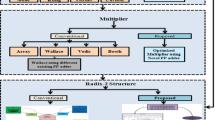Abstract
This paper talks over an efficient VLSI realization of the simplified arithmetic radix-2 Decimation In Time (DIT) Fast Fourier Transform (FFT) technique. High performance FFT processors are used in several types of signal processing, and in order to fulfil these performance demands, the processor must be parallel and pipelined. This enhanced radix-2 method is used to create an improved ASIC design that implements a fully pipelined and parallel architecture for the hardware realization of a 64 point FFT. This scheme uses lesser multipliers by reducing bit-width of twiddle representation for improved power, area and speed with a considerable Signal to Noise Ratio (SNR). A reduction of 32.8% is obtained in the area occupied, 25.08% reduction in power consumption and 20.8% improvement in speed in comparison to the Cooley–Tukey FFT realization. Compared with serial implementation an improvement of 90% and parallel implementation an improvement of 58% in latency count is observed. The design is simulated using Xilinx ISE WebPack 13.1 and synthesized using Cadence Encounter RTL Compiler with CMOS 180 nm technology.





















Similar content being viewed by others
References
R. Zekavat, R. Michael Buehrer, Digital signal processing for GNSS receivers, in Handbook of Position Location: Theory, Practice, and Advances (IEEE, 2019), pp. 707–761. https://doi.org/10.1002/9781119434610.ch21
M.Z.A. Khan, S.A. Qadeer, M.Y. Khan, Fast computation of partial DFT for comb spectrum evaluation. IEEE Signal Process. Lett. 13(12), 721–724 (2006). https://doi.org/10.1109/LSP.2006.879867
A. Samiha, B. Mohamed, H. Saliha, DFT processor implementation scheme based on Rader algorithm. IET Circuits Devices Syst. 13, 385–390 (2019). https://doi.org/10.1049/iet-cds.2018.5200
A. Gokhan, S. Levent, Introduction, in Radio Wave Propagation and Parabolic Equation Modeling (IEEE, 2018), pp. 1–14. https://doi.org/10.1002/9781119432166.ch1
V.A. Coutinho et al., A low-SWaP 16-beam 2.4 GHz digital phased array receiver using DFT approximation. IEEE Trans. Aerosp. Electron. Syst. 56(5), 3645–3654 (2020). https://doi.org/10.1109/TAES.2020.2987094
Z. Li, H. Jia, Y. Zhang, T. Chen, L. Yuan, R. Vuduc, Automatic generation of high-performance FFT kernels on arm and X86 CPUs. IEEE Trans. Parallel Distrib. Syst. 31(8), 1925–1941 (2020). https://doi.org/10.1109/TPDS.2020.2977629
Y.J. Liu, Introduction to OFDM Receiver Design and Simulation (Artech, 2019)
J.W. Cooley, J.W. Tukey, An algorithm for the machine calculation of complex Fourier series. Math. Comput. 19(90), 297–301 (1965)
D.J. Bernstein, The tangent FFT, in International Symposium on Applied Algebra, Algebraic Algorithms, and Error-Correcting Codes (Springer, Berlin, Heidelberg, 2007)
S. Winograd, On computing the discrete Fourier transform. Proc. Natl. Acad. Sci. 73(4), 1005–1006 (1976)
P. Duhamel, H. Hollmann, Split radix’FFT algorithm. Electron. Lett. 20(1), 14–16 (1984)
S. Qadeer, M.Z. Ali Khan, S.A. Sattar, A Radix-2 DIT FFT with reduced arithmetic complexity, in 2014 International Conference on Advances in Computing, Communications and Informatics (ICACCI) (IEEE, 2014)
C. Aravinth, K.K. Parhi, Serial and interleaved architectures for computing real FFT, in 2015 IEEE International Conference on Acoustics, Speech and Signal Processing (ICASSP) (IEEE, 2015)
M. Garrido, N.K. Unnikrishnan, K.K. Parhi, A serial commutator fast Fourier transform architecture for real-valued signals. IEEE Trans. Circuits Syst. II Express Briefs 65(11), 1693–1697 (2018). https://doi.org/10.1109/TCSII.2017.2753941
S. Kung, VLSI array processors. IEEE ASSP Mag. 2(3), 4–22 (1985)
H.T. Kung, C.E. Leiserson, Systolic arrays (for VLSI), in Sparse Matrix Proceedings 1978, vol 1 (Society for Industrial and Applied Mathematics, 1979)
N.J. Greg, Computationally efficient systolic architecture for computing the discrete Fourier transform. IEEE Trans. Signal Process. 53(12), 4640–4651 (2005)
X. Shih, H. Chou, Y. Liu, VLSI design and implementation of reconfigurable 46-mode combined-radix-based FFT hardware architecture for 3GPP-LTE applications. IEEE Trans. Circuits Syst. I Regul. Pap. 65(1), 118–129 (2018). https://doi.org/10.1109/TCSI.2017.2725338
P. Jain, D. Mallik, S.S. Gill et al., ASIC design of 4K-point RADIX-2 FFT in 0.18 \(\mu {\rm m}\) CMOS technology. Int. J. Inf. Tecnol. 12, 1427–1433 (2020). https://doi.org/10.1007/s41870-019-00334-6
H.S. Stone, Parallel processing with the perfect shuffle. IEEE Trans. Comput. 100(2), 153–161 (1971)
D.S. Jr Parker, Notes on shuffle/exchange-type switching networks. IEEE Trans. Comput. 3, 213–222 (1980)
M.Y. Tai, A VLSI-oriented parallel FFT algorithm. IEEE Trans. Signal Process. 44(2), 445–448 (1996)
S. Arish, R.K. Sharma, An efficient floating point multiplier design for high speed applications using Karatsuba algorithm and Urdhva–Tiryagbhyam algorithm, in 2015 International Conference on Signal Processing and Communication (ICSC) (IEEE, 2015)
S. He, M. Torkelson, A systolic array implementation of common factor algorithm to compute DFT, in International Symposium on Parallel Architectures, Algorithms and Networks, 1994. (ISPAN) (IEEE, 1994)
H. Lim, E.E. Swartzlander, Multidimensional systolic arrays for the implementation of discrete Fourier transforms. IEEE Trans. Signal Process. 47(5), 1359–1370 (1999)
G.K. Ganjikunta, S.K. Sahoo, An area-efficient and low-power 64-point pipeline Fast Fourier transform for OFDM applications. Integr. VLSI J. 57(C), 125–131 (2017)
K. Harsha, S. Qadeer, S. Azeemuddin, Z.A. Khan, Parallel and Pipelined VLSI Implementation of the new radix-2 DIT FFT algorithm, in 2018 IEEE International Symposium on Smart Electronic Systems (iSES) (IEEE, 2018)
Funding
No funding was provided by completing this research.
Author information
Authors and Affiliations
Corresponding author
Ethics declarations
Conflict of Interest
The authors declare that they have no conflict of interest.
Additional information
Publisher's Note
Springer Nature remains neutral with regard to jurisdictional claims in published maps and institutional affiliations.
Rights and permissions
Springer Nature or its licensor (e.g. a society or other partner) holds exclusive rights to this article under a publishing agreement with the author(s) or other rightsholder(s); author self-archiving of the accepted manuscript version of this article is solely governed by the terms of such publishing agreement and applicable law.
About this article
Cite this article
Qadeer, S., Keerthan, H., Azeemuddin, S. et al. Low Power and Complexity Implementation of the Modified FFT with a New Bit-Slicing Scheme. J. Inst. Eng. India Ser. B 104, 1285–1302 (2023). https://doi.org/10.1007/s40031-023-00923-x
Received:
Accepted:
Published:
Issue Date:
DOI: https://doi.org/10.1007/s40031-023-00923-x




